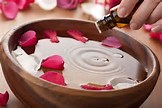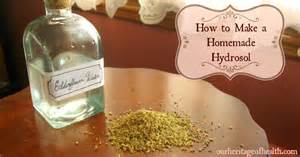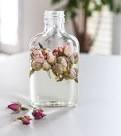The Educated Consumer





The Educated Consumer
When a well-known natural-body-care company opened its first store in Toronto, I visited this beautiful boutique with a colleague. We explored the store, sniffing merrily away until we came to the essential oils. There were testers, so, of course, a drop instantly went on the hand, and....lo and behold , it contained carrier oil, a vegetable oil used to dilute the pure essential oil, a vegetable oil used to dilute the pure esential oil. When we asked the sales person about this, we were told that these were the purest oils available, and no, they were not diluted in anyway.
Even when we pointed out that although they were certainly good quality, they were actually "oily" or greasy to the touch, and not completely volatile, as true essential oils should be, the sales person referred to the label copy, which said they were pure and did not mention any dilution. Obviously we were mistaken, for these were clearly undiluted.
Unconvinced, we asked the sales person to make a call, just to check. Four phone calls later she finally found the person who could tell her that, indeed, these oils were diluted, in fractionated coconut oil, to be precise, and that they were at 30 percent concentration. This was in 1996.Since then the labelling has been changed, and all this company's essential oils now state very clearly that they are diluted in coconut oil.
If a reputable "natural-health" company can do this, what is being done by companies that have no interest in the bigger picture but just want to make a profit using the most effective marketing tag?
The truth is no one is going to protect you and your health except you. The more information you have, the better able you will be to make good choices, thus controlling your exposure to synthetics, carcinogens, preservatives, and toxins of all kinds. This level of awareness is the minimum necessary if your intention is to maintain and preserve health.
The inclination of a growing proportion of the world's population is to return to more-natural less-processed products, whether they be food, drinks, body-care items, or supplements. True aromatherapy is one of these natural-product families; Synthetic fragrances are not. It is up to you the consumer, to know what it is you are looking for, to do your own homework and not just rely on the information provided on labels and by store staff.
Although some store employees are extremely knowledgeable, in other case a little knowledge is a dangerous thing. Some times you will be given wrong information; other times you may be deliberately misled. In fact, there is probably more misinformation than good information out there, or maybe the good information is just harder to get.
Reference: Hydrosols: Suzanne Catty
What is Aromatherapy?






What is Aromatherapy
Aromatherapy is a branch of phytotherapy or plant therapy, just as herbalism, homeopathy, flower remedies, traditional Chinese medicine, and many other treatments are also phytotherapy. Aromatherapy is holistic, concerning itself with the whole of the person and attempting to create balance for the whole of the body.
Aromatherapy [practice has been documented in dome form or another for more than four thousand years but went through a major reassessment and earned its modern name during the first World War. This renaissance has taken aromatherapy into many worlds: the chemical exploration of hard science, the hallowed halls of modern medicine, and the metaphysical realms of spirituality.
Now as we enter the twenty-first century, I believe it is changing again. The aromatherapy of the future will no longer segregate the different avenues of aromatic practice but will allow them to coalesce in one broad modality.
Even now aromatherapy exhibits its own energy, a blend of thoughts and methods in which the total is greater than the sum of the parts, magic cohabits with chemistry, botany lives with bodywork, and layperson practitioners have as much chance of healing themselves as professionals. It leaves and breathes and grows just as the plants from which it comes.
Aromatherapy, in the truest sense of the word, is the use of 100 per cent natural whole, unadulterated , aromatic essences obtained from specific botanical sources by steam distillation or expression for their benefits of mind, body and spiritual health.
These essences may be pure essential oils, the non-water-soluble, volatile aromatic compounds found in flowers, leaves, branches, seeds, roots, barks, resins and fruits and obtained by gentle distillation. They may also be the expressed oils found in the rinds of citrus fruits like lemon, orange, bergamot, and grapefruit, which are gathered by squeezing the oil from the peel.
Aromatherapy also involves the use of nonvolatile fatty oils (carrier oils) found in avocados, sesame seeds, and exotics such as rosehips and hazelnuts. Last but not least, aromatherapy uses hydrosols, the aromatic waters coproduced during the steam distillation of essential oils. What is most important is that the substances used in the creation and maintenance of health be totally pure and from very specific plants.
What aromatherapy is not is the use of synergistic substances such as perfumes and fragrant oils, nor is it simply the use of "anything that smells".
Aromatherapy products are not made in a plant (factory) but in a plant (living growing , green thing). They are not merely perfumes. The bulk of items marked as aromatherapy on the shelves of pharmacies, department stores, cosmetic suppliers, spas and even health food stores are not true aromatherapy. They may be "smelly" but they are not exclusively natural. Many have never seen a plant (living, growing, green thing), and some may contain ingredients linked to, or suspected of causing , serious health problems and allergic reactions, yet the label calls them aromatherapy all the same. Given all that's out there, what's a person to do?
The bottom line is that we are in uncharted territory. We are working in a world where no clear differentiation exists between things that are natural and aromatic and things that are synthetic and aromatic, a zone where there is no perceived difference between smells that heal and smells that harm where no law exists.
At the present there are few controls on the creative license used by those who write the labels and market the products, unless they are medicines. A bottle may say that it contains "only 100 percent essential oil." There are no requirements that other ingredients, such as carrier oils, perfume industry chemicals , or even common alcohol, be listed on the label. You may buy this bottle thinking that what you are getting is the real thing, but the real thing only contributes to a fraction to the price you are paying.
Reference:Hydrosols: Suzanne Catty
One Single, Botanically Specific Plant



One Single, Botanically Specific Plant
Plant-based products for therapeutic applications must be derived from one single, botanical specific source. If we look at peppermint, we see that it is just one of many mints, including spearmint, corn mint, pennyroyal, orange, mint, apple mint. and so on. Botanically specific peppermint oil or hydrosol must come from a distillation of Mentha piperita alone.
Weeds are contaminants, as are other kinds of mints, since they contain chemicals and aromatic compounds that affect both the smell and the properties of the final product.
Theren are also many varieties of peppermint, and each has a different chemical structures. The country of origin, rainfall, temperature, altitude, insect and pest interaction, method of agriculture, and use of chemicals are factors that further the influence these differences.Distillers of plants destined for use in therapeutic applications must be able to ensure not only that it is just peppermint that they harvest but that it is the desired variety. Most aromatherapists prefer Mentha piperita var. Mitcham for therapeutic use. Its fragrance is soft and sweet, and chemically it is low in the keytone menthone and the oxide menthofurane but high in the desirable alcohol menthol. Once available only from Europe, this type of mint is now produced in the United States.
Reference: Hydrosols: suzanne Catty
The Desired Quality Parameters










The Desired Quality Parameters
I came to know hydrosols as a coproduct of the distillation of essential oils. Therefore the parameters that I have followed in selecting and judging quality in a hydrosol are the same as those that I use for essential oils.
I have always believed that anyone working with natural products must bear in mind environmental issues and, in fact, should cultivate a relationship with the living planet and the energetic elements: earth, air, fire, water and spirit.
The environmentalist David Suzuki, in his book The Sacred Balance, devotes an entire chapter to each of the elements and another to love. From his point of view, we are the air we breathe, the earth from which our food and medicine come, the water from which we are born and of which our bodies are made, and the fire that is the spark that animates all life. I share this view and will talk about aromatherapy and hydrosols in the context of the same philosophy.
Our health is inextricably linked to the health of our planet, Gaia, and we cannot isolate what we do and our pursuit of health into a merely personal experience: it is a global experience, a spiritual path, and a serious responsibility.
Parameters for selecting and evaluating quality in aromatherapy products:
- One single, botanically specific plant
Certified organic or biodynamic agriculture
Chemical-free agriculture
Sustainability wild-crafted and tested chemical contaminants
Distilled or extracted specifically for therapeutic use
Stored and transformed to maintain therapeutic values
Reference: Hydrosols: Suzanne Catty
Articles - Most Read
- Home
- What are Hydrosols
- What are Hydrosols-2
- The Monographs
- How to Make a Hydrosol
- Table of Common Latin Names and pH Values - F - O
- Distilled or Extracted Specifically For Therapeutic Use - 3
- Kurt Schnaubelt
- What isn't a Hydrosol?
- Table of Common Latin Names and pH Values - P - S
- Wholly Water!
- Blue Babies
- Supply and Demands
- Mature Skin
- Recipes Alpha F
- Hydrosols In The Marketplace
- Chemicals: Friends or Foes?
- Hemorrhoids
- Nelly GrosJean
- Water as Medicine
- The Educated Consumer
- Genitically Modified Plants
- Influences
- Water Quality
Articles-latest
- Daucus carota/Wild Carrot Seed - pH 3.8-4.0
- Cupressus sempervirens/ Cypress-pH3.5-3.7
- Coriandrum sativum/Coriander Herb-and-Seed
- Comptonia peregrinal/Sweet Fern- pH 3.8
- Citrus clementine (fe) Clementine Petitgrain- pH 4.3-4.4
- Citrus aurantium var. amara (flos) /Neroli Orange Blossom-pH3.8-4.5
- Cistus ladaniferus/Rock Rose-pH 2.9-3.1
- Cinnamomum zeylanicum (ec) Cinnamon Bark-pH3.3
- Chamaemelum nobile/Roman Chamomile - pH 3.0-3,3
- Centaurea cyanus/Cornflower/Bachelor's Button-pH 4.7-5.0
- Cedrus atlantical/Cedarwood/Atlas Cedar-pH 4.1- 4.2
- Hydrosols -The PH - Anomalies
- Hydrosols- Establishing Shelf Life and Stability
- Boswellia carterii/FRANKINCENSE
- Asarum canadense/ Wild Ginger/Canadian Ginger
- Artemesia vulgaris / Artemesia
- ARTEMESIA DRACUNCULUS - TARRAGON
- Angelica archangelica / Angelica Root - Hydrosols
- The Key, or More Correctly, the pH - 2 - Hydrosols
- The Key, or More Correctly, the pH-Hydrosols
- The Hard pHacts - Hydrosols
- Calamus Root/Sweet Flag - ACORUS CALAMUS
- Yarrow - Achillea millefolium - Hydrosols
- Balsam Fir - Abies balsamea - Hydrosols

